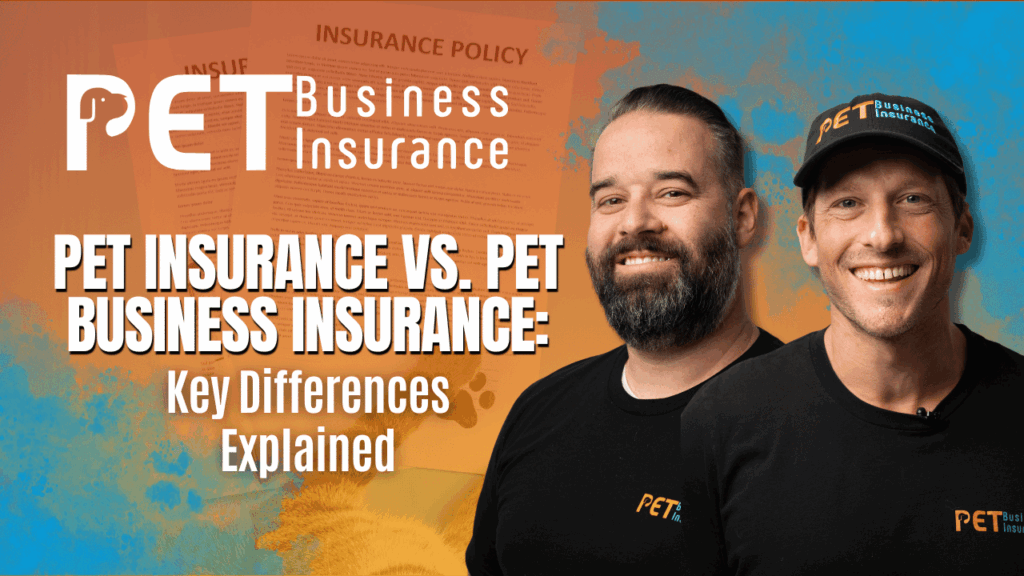
Confusion between pet insurance and pet business insurance is common—and it can lead to costly gaps in protection. Whether you’re a pet owner, a business operator, or both, knowing which type of coverage you need (and when) is essential for managing risk and avoiding surprises when something goes wrong.
Imagine this: A dog groomer owns two pets at home and also runs a grooming salon. When her dog needs emergency surgery, her business policy doesn’t cover the cost. Later, when a client’s dog bites someone at her facility, her personal pet insurance doesn’t help. These real-world situations highlight the difference between policies that protect your pets and those that protect your business.
This article will clarify:
- What pet insurance does and does not cover
- What pet business insurance includes—and why it’s essential
- How to determine if you need one or both
- Common misconceptions that can cost you
What Pet Insurance Actually Covers (and Doesn’t)
Pet insurance is designed for individuals who want help managing the cost of veterinary care.
At its core, pet insurance reimburses pet owners for medical expenses related to illness or injury. Coverage often includes:
- Accidents and emergency care
- Chronic conditions like diabetes or arthritis
- Surgery and hospitalization
- Prescription medications
- Some advanced treatments (e.g., chemotherapy, physical therapy)
- Optional add-ons for wellness and dental care
However, pet insurance is not comprehensive. Most policies do not cover:
- Pre-existing conditions
- Routine care like checkups or vaccines (unless added separately)
- Cosmetic or elective procedures
- Breeding-related expenses
- Liability for injuries caused by your pet
The typical process involves paying your vet out of pocket, then submitting a claim for reimbursement. Most plans include deductibles, annual limits, and waiting periods before coverage begins.
What Pet Business Insurance Protects
Pet business insurance protects your operations, employees, and clients—not your personal animals.
This coverage is essential for anyone offering pet-related services, such as grooming, sitting, training, or boarding. Key coverage types include:
- General Liability Insurance: Covers injuries to customers or damage to property caused by animals in your care.
- Professional Liability Insurance: Covers claims related to service errors—such as grooming injuries or training mishaps.
- Commercial Property Insurance: Protects your facility, equipment, and inventory against fire, theft, or weather damage.
- Business Income Insurance: Replaces lost income if your operations are interrupted due to covered events.
- Animal Bailee Coverage: Protects against injury, illness, or death of client animals while in your care.
- Workers’ Compensation Insurance: Required if you have employees; covers work-related injuries.
- Commercial Auto Insurance: Required for vehicles used in your business, such as for mobile grooming or pet transport.
These coverages are tailored to the risks of operating a business and differ significantly from the personal nature of pet insurance.
When You Might Need Both Types of Coverage
If you own pets and also operate a pet-related business, one policy will not protect you on both fronts.
Some common examples where both types are needed include:
- A groomer whose personal pet becomes ill. Business insurance won’t cover the vet bill.
- A pet sitter whose dog bites a client. Pet insurance won’t cover the liability.
- A kennel owner who brings their own pets to work. The business policy excludes personal animals.
Personal pet insurance protects your animal’s health. Business insurance protects your liability and operations. It’s important to evaluate them separately and avoid assuming one policy “covers everything.”
Common Misconceptions That Lead to Costly Mistakes
Assuming one type of insurance does it all is one of the biggest errors people make.
Here are frequent misunderstandings:
- “My business policy covers my own pets.” It doesn’t. Your animals are not clients.
- “Pet insurance covers injuries my pet causes.” It won’t. That’s usually a homeowners or business liability issue.
- “I don’t need business insurance because I’m small.” Even a one-person operation can face a lawsuit or property damage.
Both types of insurance have their own triggers and exclusions. Knowing those differences can help you avoid uncovered claims and financial stress.
Choosing the Right Insurance for Your Needs
Start with a risk assessment based on your role.
- If you’re a pet owner, consider the age, breed, and health risks of your pet. Compare pet insurance policies for coverage, cost, and exclusions.
- If you run a pet-related business, assess your services, equipment, property, and customer interactions. Business owner policies often bundle multiple protections. Make sure to ask about add-ons like animal bailee or professional liability.
- If you are both, shop for each type of policy independently. Some insurers offer bundled options, but never assume they overlap.
Understanding the distinctions between pet and pet business insurance isn’t just smart—it’s critical to avoiding coverage gaps that only become obvious when it’s too late.
Next Steps
If you’re unsure which type of coverage you need—or whether you need both—take inventory of your roles and risks. The best insurance decisions come from knowing what you’re responsible for, what could go wrong, and what protections are truly in place.
Still have questions about what each type of insurance includes? Reading a side-by-side comparison chart or talking with a specialized insurance advisor is often the best place to start.

